Tallaght Castle
| Tallaght Castle | |
|---|---|
| site of The Priory Institute Tallaght, in County Dublin | |
|
View of the Antient Archiepiscopal Palace, Tallaght. 1873 | |
| Coordinates | 53°17′21″N 6°21′39″W / 53.289161°N 6.360861°WCoordinates: 53°17′21″N 6°21′39″W / 53.289161°N 6.360861°W |
Tallaght Castle (also known as Tallaght House[1] and formerly known as the Archiepiscopal Palace[2]) was a castle in Kilnamanagh, Tallaght, County Dublin, Ireland.[3] It dates from the 14th Century.[4] It became an official residence of the Church of Ireland Archbishop of Dublin until 1822.[5][6][7][4] It was taken over by the Dominican Order in 1856.[4][8]
Members of Archbishop Loftus's family were killed at the gates of the castle in the 1570s.[9]
The castle is now in ruins with only a small proportion of it incorporated into the St. Mary's Priory building,[2] in the grounds of St. Mary's Dominican Priory and the Priory Institute[4] The old palace gardens, Archbishop’s bathhouse, the Friar's Walk and St. Maelruain's Tree still remain in the current grounds.[10]
Development
Tallaght village was first walled in about 1310.[11] As ordered by Archbishop Alexander de Bicknor the initial castle was built between 1324 and the 1340s, to defend the town.[11][2][10][12] The original castle is thought to have comprised high walls with a courtyard in the centre.[11] It was in a bad condition a century later.[10][12][2]
In the mid 1400s, improvements were made by Archbishop Michael Tregury, leading to an increase in usage by subsequent Archbishops.[9]
Archbishop John Hoadly built a palace on the remains from 1727 to 1729 at a cost of £2,500.[2][13][12][5][7][10][1] The grounds had a brewery and a granary and stables.[10] By 1760 some of the buildings had become 'dilapidated'.[5]
In 1821, an Act of Parliament, was passed which stated that it was unfit for habitation.[2][10][12] In 1822 the property was sold to Major Palmer, Inspector General of Prisons, who pulled most of the palace down and used the materials to build his mansion, 'Tallaght House', as well as a schoolhouse and several cottages. A tower from the original castle was left untouched and later was incorporated in the current priory building.[12][14] The once four-storey-high tower now has just internally two.[2][10] Major Palmer later sold the mansion and lands to his successor as Inspector of Prisons, Mr. Lentaigne.[2]
When the Dominican friars took a lease out on the property in the 1840s,[1][4] one of the buildings was converted into a chapel.[10] The friars eventually bought the property from Mr. Lentaigne in 1855.[2] The chapel was replaced with a purpose built church, dedicated to Fr. Tom Burke, in 1883.[2]Part of the house burned down in the first decade of the 1900s.[1]
References
- 1 2 3 4 "Where Father Burk Died". The Intermountain Catholic. Salt Lake City, Utah. 26 October 1907. p. 6. Retrieved 21 August 2014 – via Newspapers.com.

- 1 2 3 4 5 6 7 8 9 10 "1729 – Archiepiscopal Palace, Tallaght, Co. Dublin". archiseek.com. Archived from the original on 10 April 2018. Retrieved 10 April 2018.
- ↑ Erck, John Caillard (1827). The ecclesiastical register: containing the names of the dignitaries and parochial clergy of Ireland : as also of the parishes and their respective patrons and an account of monies granted for building churches and glebe-houses with ecclesiastical annals annexed to each diocese and appendixes : containing among other things several cases of quare impedit. R. Milliken and Son.
1324 Tallaght-castle - remission of money granted to the archbishop of Dublin, on the 26th July in the seventheenth year of Edward II in consideration of his building Tallaght castle
- 1 2 3 4 5 Clark, Trish (2010). "Dominican Retreat Centre". France, United Kingdom, Ireland. Hidden Spring. p. 276. ISBN 9781587680571.
- 1 2 3 Wilde, William Robert (1880). Memoir of Gabriel Beranger: And His Labours in the Cause of Irish Art and Antiquities, from 1760 to 1780. M.H. Gill & Son. pp. 6–7.
- ↑ Stokes, George Thomas (1900). Hugh Jackson Lawlor, ed. Some Worthies of the Irish Church: Lectures Delivered in the Divinity School of the University of Dublin. Hodder and Stoughton. p. 106.
- 1 2 "Labours in the cause of Irish Art, etc.". The journal of the Royal Historical and Archaeological Association of Ireland. Royal Historical and Archaeological Association of Ireland. 1870. p. 39.
- ↑ "<no title>". The Morning News. Belfast, Northern Ireland. 25 June 1887. page 5, column 3.
- 1 2 Elrington Ball, Francis. "A History of the County Dublin: Tallaght, Cruagh, Whitechurch, Kilgobbin, Kiltiernan, Rathmicheal, Old Connaught, Saggart, Rathcoole, and Newcastle". p. 8. Missing or empty
|url=(help) - 1 2 3 4 5 6 7 8 "Tallaght - History". [SouthDublinHistory.ie]. 2016. Archived from the original on 29 August 2016. Retrieved 21 August 2017.
- 1 2 3 "Tallaght Castles". [Tallaght4Kids.ie]. Archived from the original on 21 August 2017. Retrieved 21 August 2017.
- 1 2 3 4 5 "Tallaght Castle". Ask About Ireland. Archived from the original on 4 July 2014. Retrieved 21 August 2017.
- ↑

- ↑ "Tallaght Heritage Walk. Tallaght Castle: Stop 20". South Dublin Libraries. Retrieved 21 August 2017.
